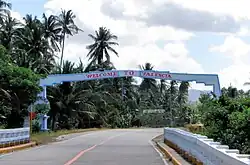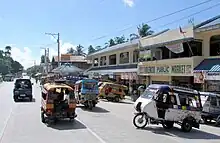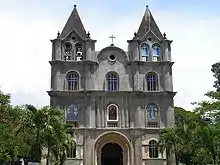Valencia | |
|---|---|
| Municipality of Valencia | |
 Valencia welcome arch | |
 Flag  Seal | |
 Map of Bohol with Valencia highlighted | |
OpenStreetMap | |
.svg.png.webp) Valencia Location within the Philippines | |
| Coordinates: 9°36′35″N 124°12′29″E / 9.6097°N 124.208°E | |
| Country | Philippines |
| Region | Central Visayas |
| Province | Bohol |
| District | 3rd district |
| Founded | 1867 |
| Named for | Valencia, Spain |
| Barangays | 35 (see Barangays) |
| Government | |
| • Type | Sangguniang Bayan |
| • Mayor | Dionisio Neil A. Balite |
| • Vice Mayor | Aristotle C. Cometa |
| • Representative | Kristine Alexie B. Tutor |
| • Municipal Council | Members |
| • Electorate | 18,191 voters (2022) |
| Area | |
| • Total | 116.67 km2 (45.05 sq mi) |
| Elevation | 75 m (246 ft) |
| Highest elevation | 485 m (1,591 ft) |
| Lowest elevation | 0 m (0 ft) |
| Population (2020 census)[3] | |
| • Total | 28,392 |
| • Density | 240/km2 (630/sq mi) |
| • Households | 6,072 |
| Economy | |
| • Income class | 4th municipal income class |
| • Poverty incidence | 22.00 |
| • Revenue | ₱ 126.1 million (2020) |
| • Assets | ₱ 493 million (2020) |
| • Expenditure | ₱ 123.4 million (2020) |
| • Liabilities | ₱ 34.43 million (2020) |
| Service provider | |
| • Electricity | Bohol 2 Electric Cooperative (BOHECO 2) |
| Time zone | UTC+8 (PST) |
| ZIP code | 6306 |
| PSGC | |
| IDD : area code | +63 (0)38 |
| Native languages | Boholano dialect Cebuano Tagalog |
Valencia, officially the Municipality of Valencia (Cebuano: Munisipalidad sa Valencia; Tagalog: Bayan ng Valencia), is a 4th class municipality in the province of Bohol, Philippines. According to the 2020 census, it has a population of 28,392 people.[3]
It is on the southern coast of Bohol, 46 kilometres (29 mi) from Tagbilaran.
There are elementary schools in the poblacion and in the barrios. For their secondary education, students go to Valencia High School, a public school.
Valencia is the birthplace of former Executive Secretary Juan Pajo.[5]
Valencia celebrates its feast on every 3rd Saturday of January to honor the town patron saint, Sr. Santo Niño.[6]
History
Its former name used to be Panangatan, which comes from the root word sang-at, meaning "to put up on an elevated place". This referred to the practice of fishermen from Dimiao and Lila who would put up (sang-at) their boats on the banks of the Panangatan River when taking shelter during the southwest monsoons. Here nipa palms grew along the river, preventing the boats from being washed away by the waves.[7]
Panangatan remained part of Dimiao until 1867. That year a Spanish priest was assigned to the place and it became a separate municipality. The priest gave it a new name, naming after his birthplace in Spain. In 1879 Valencia had a population of 7,009.
Geography
Barangays
Valencia is politically subdivided into 35 barangays:. Each barangay consists of puroks and some have sitios.
| PSGC | Barangay | Population | ±% p.a. | |||
|---|---|---|---|---|---|---|
| 2020[3] | 2010[8] | |||||
| 071247001 | Adlawan | 1.7% | 493 | 588 | −1.75% | |
| 071247002 | Anas | 6.1% | 1,719 | 1,826 | −0.60% | |
| 071247003 | Anonang | 3.1% | 888 | 972 | −0.90% | |
| 071247004 | Anoyon | 1.8% | 497 | 496 | 0.02% | |
| 071247005 | Balingasao | 7.7% | 2,193 | 2,297 | −0.46% | |
| 071247035 | Banderahan (Upper Ginopolan) | 3.1% | 872 | 933 | −0.67% | |
| 071247006 | Botong | 2.1% | 583 | 694 | −1.73% | |
| 071247007 | Buyog | 1.5% | 420 | 436 | −0.37% | |
| 071247008 | Canduao Occidental | 2.8% | 797 | 767 | 0.38% | |
| 071247009 | Canduao Oriental | 2.3% | 660 | 785 | −1.72% | |
| 071247010 | Canlusong | 3.8% | 1,067 | 1,020 | 0.45% | |
| 071247011 | Canmanico | 7.5% | 2,133 | 2,132 | 0.00% | |
| 071247012 | Cansibao | 3.5% | 995 | 925 | 0.73% | |
| 071247013 | Catug‑an | 1.5% | 414 | 439 | −0.58% | |
| 071247014 | Cutcutan | 3.2% | 904 | 905 | −0.01% | |
| 071247015 | Danao | 2.2% | 616 | 594 | 0.36% | |
| 071247016 | Genoveva | 1.9% | 541 | 536 | 0.09% | |
| 071247017 | Ginopolan (Ginopolan Proper) | 2.7% | 772 | 827 | −0.69% | |
| 071247018 | La Victoria | 3.5% | 984 | 1,044 | −0.59% | |
| 071247019 | Lantang | 3.6% | 1,014 | 942 | 0.74% | |
| 071247020 | Limocon | 1.1% | 311 | 424 | −3.05% | |
| 071247021 | Loctob | 2.4% | 692 | 678 | 0.20% | |
| 071247022 | Magsaysay | 2.2% | 617 | 533 | 1.47% | |
| 071247023 | Marawis | 2.0% | 563 | 587 | −0.42% | |
| 071247024 | Maubo | 1.8% | 517 | 472 | 0.91% | |
| 071247025 | Nailo | 1.6% | 462 | 461 | 0.02% | |
| 071247026 | Omjon | 4.2% | 1,192 | 1,184 | 0.07% | |
| 071247027 | Pangi‑an | 1.4% | 405 | 387 | 0.46% | |
| 071247028 | Poblacion Occidental (Sawang) | 5.3% | 1,508 | 1,496 | 0.08% | |
| 071247029 | Poblacion Oriental (Sur) | 3.2% | 917 | 928 | −0.12% | |
| 071247030 | Simang | 1.7% | 480 | 466 | 0.30% | |
| 071247031 | Taug | 1.5% | 439 | 492 | −1.13% | |
| 071247032 | Tausi-on | 2.1% | 589 | 618 | −0.48% | |
| 071247033 | Taytay | 2.3% | 651 | 639 | 0.19% | |
| 071247034 | Ticum | 2.9% | 818 | 779 | 0.49% | |
| Total | 28,392 | 27,586 | 0.29% | |||
Climate
| Climate data for Valencia, Bohol | |||||||||||||
|---|---|---|---|---|---|---|---|---|---|---|---|---|---|
| Month | Jan | Feb | Mar | Apr | May | Jun | Jul | Aug | Sep | Oct | Nov | Dec | Year |
| Mean daily maximum °C (°F) | 28 (82) |
29 (84) |
30 (86) |
31 (88) |
31 (88) |
30 (86) |
30 (86) |
30 (86) |
30 (86) |
29 (84) |
29 (84) |
29 (84) |
30 (85) |
| Mean daily minimum °C (°F) | 23 (73) |
22 (72) |
23 (73) |
23 (73) |
24 (75) |
25 (77) |
24 (75) |
24 (75) |
24 (75) |
24 (75) |
23 (73) |
23 (73) |
24 (74) |
| Average precipitation mm (inches) | 102 (4.0) |
85 (3.3) |
91 (3.6) |
75 (3.0) |
110 (4.3) |
141 (5.6) |
121 (4.8) |
107 (4.2) |
111 (4.4) |
144 (5.7) |
169 (6.7) |
139 (5.5) |
1,395 (55.1) |
| Average rainy days | 18.6 | 14.8 | 16.5 | 16.7 | 23.9 | 26.4 | 25.6 | 24.1 | 24.4 | 26.3 | 23.7 | 20.5 | 261.5 |
| Source: Meteoblue[9] | |||||||||||||
Demographics
| Year | Pop. | ±% p.a. |
|---|---|---|
| 1903 | 7,809 | — |
| 1918 | 10,555 | +2.03% |
| 1939 | 13,653 | +1.23% |
| 1948 | 15,289 | +1.27% |
| 1960 | 15,596 | +0.17% |
| 1970 | 16,888 | +0.80% |
| 1975 | 18,229 | +1.54% |
| 1980 | 18,655 | +0.46% |
| 1990 | 20,879 | +1.13% |
| 1995 | 22,423 | +1.35% |
| 2000 | 24,363 | +1.79% |
| 2007 | 28,043 | +1.96% |
| 2010 | 27,586 | −0.60% |
| 2015 | 27,126 | −0.32% |
| 2020 | 28,392 | +0.90% |
| Source: Philippine Statistics Authority[10][8][11][12] | ||
Economy

The principal industries of the people today are weaving, pot making, and fishing. The most important produce is coconuts, rice, corn and fish.
Market day, locally known as Tabu, is Sunday. Local produce such as fresh fruits, vegetable, fresh meat and live poultry are sold. The days of this weekly community occasion differ from town to town.
Badiang Spring resort in barangay Anas is a major contribution to local economic activity. Badiang Spring has continuously flowing water from subterranean rocks, which is its main attraction. Not just domestic tourists but foreign tourists too frequent the 1,250-square-metre (13,500 sq ft) lot by the shore. Badiang Spring has separate swimming pools for adults and children as well as accommodation facilities.
Culture
Valencia Parish Church

The parish of the Santo Niño and the town of Valencia began as barrio Panangatan of Dimiao. Together with adjacent barrios, it was constituted a town in 1869 and a parish in 1871 and named after a city on Spain's southern coast. The church building commenced during the term of Fray Mariano Cornago (1870–77) and was completed in 1882 by Fray Francisco Arraya, who laid the church's wooden floor. The church walls were of tabique but were later replaced by cement.
Heritage Site: The church is cruciform with a steep roof and a pyramidal crossing tower. Cut stone is used in parts of the church like the façade, however, concrete is found elsewhere. The real treasure of the church is its wooden floor of alternating dark (tindalo or balayong) and light (molave or tugas) wood planks. At the transept crossing an eight pointed flower design is used for the floor, while a herringbone pattern is used elsewhere. The interior is unpainted, unlike most Bohol churches and has altars in the neoclassical idiom.
The convent is located not beside the church as is customary but across the street. This structure was renovated in the 19th century. The fencing of the entire campus of the convent is recent.
References
- ↑ Municipality of Valencia | (DILG)
- ↑ "2015 Census of Population, Report No. 3 – Population, Land Area, and Population Density" (PDF). Philippine Statistics Authority. Quezon City, Philippines. August 2016. ISSN 0117-1453. Archived (PDF) from the original on May 25, 2021. Retrieved July 16, 2021.
- 1 2 3 Census of Population (2020). "Region VII (Central Visayas)". Total Population by Province, City, Municipality and Barangay. Philippine Statistics Authority. Retrieved 8 July 2021.
- ↑ "PSA Releases the 2018 Municipal and City Level Poverty Estimates". Philippine Statistics Authority. 15 December 2021. Retrieved 22 January 2022.
- ↑ "Welcome to Valencia Bohol". www.bohol-philippines.com. Retrieved 2019-05-02.
- ↑ "Bohol Festivals Timetable". www.bohol-philippines.com. Retrieved 2019-03-21.
- ↑ "How Valencia Came To Being?". www.bohol-philippines.com. Retrieved February 15, 2019.
- 1 2 Census of Population and Housing (2010). "Region VII (Central Visayas)" (PDF). Total Population by Province, City, Municipality and Barangay. National Statistics Office. Retrieved 29 June 2016.
- ↑ "Valencia: Average Temperatures and Rainfall". Meteoblue. Retrieved 9 May 2020.
- ↑ Census of Population (2015). "Region VII (Central Visayas)". Total Population by Province, City, Municipality and Barangay. Philippine Statistics Authority. Retrieved 20 June 2016.
- ↑ Censuses of Population (1903–2007). "Region VII (Central Visayas)". Table 1. Population Enumerated in Various Censuses by Province/Highly Urbanized City: 1903 to 2007. National Statistics Office.
{{cite encyclopedia}}: CS1 maint: numeric names: authors list (link) - ↑ "Province of Bohol". Municipality Population Data. Local Water Utilities Administration Research Division. Retrieved 17 December 2016.
- ↑ "Poverty incidence (PI):". Philippine Statistics Authority. Retrieved December 28, 2020.
- ↑ "Estimation of Local Poverty in the Philippines" (PDF). Philippine Statistics Authority. 29 November 2005.
- ↑ "2003 City and Municipal Level Poverty Estimates" (PDF). Philippine Statistics Authority. 23 March 2009.
- ↑ "City and Municipal Level Poverty Estimates; 2006 and 2009" (PDF). Philippine Statistics Authority. 3 August 2012.
- ↑ "2012 Municipal and City Level Poverty Estimates" (PDF). Philippine Statistics Authority. 31 May 2016.
- ↑ "Municipal and City Level Small Area Poverty Estimates; 2009, 2012 and 2015". Philippine Statistics Authority. 10 July 2019.
- ↑ "PSA Releases the 2018 Municipal and City Level Poverty Estimates". Philippine Statistics Authority. 15 December 2021. Retrieved 22 January 2022.